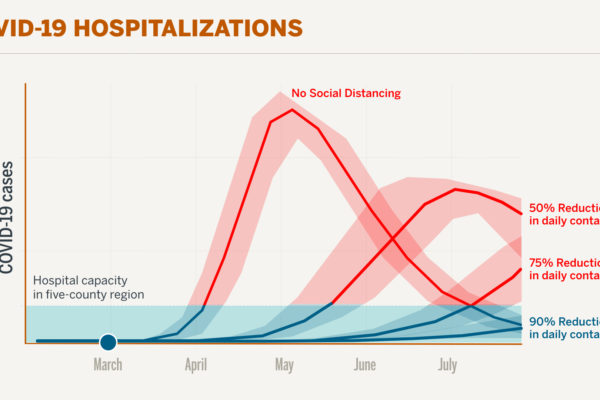UPDATE: Revised model projections were released on April 6. Read the full report.
AUSTIN, Texas — Since 2012 a pandemic-planning tool developed by researchers at The University of Texas at Austin has helped public health officials plan for the consequences of a deadly and virulent virus. Now the pandemic modeler who developed the toolkit is studying COVID-19 and has built a new model to project the spread of COVID-19 across the U.S. She has teamed up with Dell Medical School to assess the potential impact of the pandemic in the Austin-Round Rock area.
Preliminary results from the local analysis were shared with Austin city officials and are being made public in a report today in advance of scientific peer review due to the time-sensitive nature of the subject. The models clarify that without stringent social distancing, COVID-19 may overwhelm hospital capacities in the Austin-Round Rock area by this summer.
Initial simulations of the spread of COVID-19 in the area, using UT’s pandemic model, showed that reducing daily contacts in the community by 50% – or even 75% – may not be sufficient to prevent an unmanageable surge in COVID-19 hospitalizations in the five-county area (Travis, Williamson, Bastrop, Caldwell and Hays). However, the model suggests that reducing daily contacts between people by 90% “flattened the curve” enough to ensure that enough hospital beds, ventilators and other resources could be available in the Austin-Round Rock area during the next few months.
“The takeaway from this analysis is that the extent of social distancing measures and our willingness to adhere to them will directly impact not only the fate of the outbreak but also our capacity to provide life-saving health care for those in need,” said Lauren Ancel Meyers, a professor of integrative biology and statistics and data sciences who prepared the initial results.
UT Researcher Explains COVID-19 Projections, Need for Social Distancing from University of Texas at Austin on Vimeo.
Meyers applies mathematical models and computers at UT’s Texas Advanced Computing Center (TACC) to understand, analyze and predict the transmission of diseases and their effects. Her models use available data about how quickly a disease spreads, how many people a single case is likely to infect, demographic and transportation factors and policy choices, such as school closures and other social distancing measures, on factors such as total deaths, infections and health care resource availability.
Meyers and a team at TACC developed the original Texas Pandemic Flu Toolkit, a web-based service that simulates the spread of pandemic flu through the state, to forecast the number of flu hospitalizations and help hospitals determine where and when to place ventilators to minimize fatalities. The tool also provides visualizations that help decision-makers better understand the potential for spread of a disease and models that can assist with rapid and fair distributions of antiviral drugs and vaccines, when such medical countermeasures become available.
The new COVID-19 models, like the Texas pandemic toolkit, are intended to both guide planning in advance of future pandemics and provide rapid analyses to support real-time decision-making during emergency situations. Meyers’ model shows that with current stringent distancing measures in place in many parts of the metropolitan area, the pandemic is less likely to crest this summer than would otherwise be the case. Several uncertainties exist in the model, and the research relies on a series of assumptions about how quickly the virus spreads, how long people remain sick, how many people will be hospitalized and how many cases exist in the community.
“These projections assume, based on the latest data from COVID-19 outbreaks around the globe, that the number of new infections in a community doubles about every four days, and that almost 1 out of every 20 people who contract the virus will need hospitalization,” Meyers said.
Meyers’ research is funded by the National Institutes of Health, and she holds UT Austin’s Denton A. Cooley Centennial Professorship.




